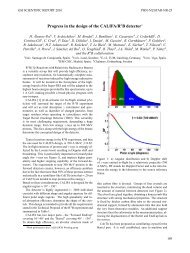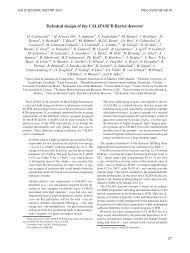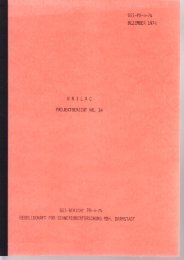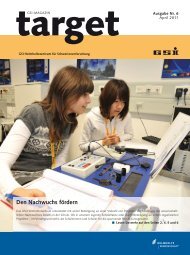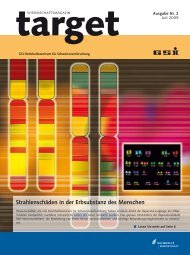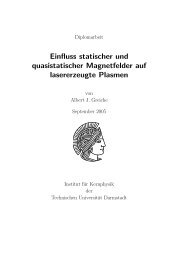download block - GSI Helmholtzzentrum für Schwerionenforschung
download block - GSI Helmholtzzentrum für Schwerionenforschung
download block - GSI Helmholtzzentrum für Schwerionenforschung
You also want an ePaper? Increase the reach of your titles
YUMPU automatically turns print PDFs into web optimized ePapers that Google loves.
<strong>GSI</strong>-ACCELERATORS-02 <strong>GSI</strong> SCIENTIFIC REPORT 2009<br />
130<br />
Figure 1: Two–dimensional ion beam profiles of Ar 8+ ion<br />
beams at the location of the RFQ entrance for different settings<br />
of the LEBT.<br />
and the instrumentation, the infrastructure and the controls<br />
of the test bench were functional in late 2009.<br />
In order to establish a standard procedure for the production<br />
of 50 Ti beams from highly enriched materials a test series<br />
was started at the EIS to investigate different types of<br />
evaporation ovens.<br />
High Current IS and Penning IS<br />
The PIG source has been used for regular operation of<br />
the accelerator. No specific development was necessary to<br />
satisfy the beam time requirements.<br />
Table 2: Ion beams delivered from the PIG Injector in 2009.<br />
Ion Auxiliary Duration Analyzed intensity<br />
species gas (days) (eµA)<br />
40 Ar +,2+ - 16 150 ... 400<br />
56 Fe 3+ Ar 3 150<br />
58 Ni 2+,3+ Ar 13 10 ... 100<br />
96 Ru 2+ Ar 22 25<br />
136 Xe 3+ - 8 90<br />
197 Au 8+ Ar 12 250<br />
238 U 4+,10+ Ar, Xe 25 10 ... 100<br />
For the planned Li-experiment the PIG source has been<br />
tested with a specific alloy as sputter electrode which<br />
provided good experience in earlier times with an axial<br />
PIG ion source. The used PIG at <strong>GSI</strong> however has a<br />
radial extraction, which is a substantially different plasma<br />
confinement. At the test bench for the PIG source we<br />
could demonstrate a high fraction of Lithium in the beam,<br />
comparing the ratio of mass 14 N 1+ and mass 7 (N 2+<br />
and Li 1+ ). Whether meta-stable ions are in the beam at<br />
all or what the percentage of meta-stable ions in the beam<br />
is could not determined due to missing diagnostic elements.<br />
The new MUCIS has been set into operation very successfully<br />
for a long period Ar beam time. With this ion<br />
source, designed in 2008 it was possible to increase the<br />
extractable ion current by 10% at even lower arc power,<br />
which indicates a better plasma confinement. Main differences<br />
to the existing version of this source is an enlarged<br />
discharge chamber, a coaxial cathode holder, and an improved<br />
magnetic flux distribution. The higher efficiency of<br />
the ion source results in a longer life time of the filaments.<br />
Table 3: Ion beams delivered from the High Current Injector<br />
in 2009.<br />
Ion Auxiliary Duration analyzed intensity<br />
species gas (days) (emA)<br />
1 H + 3 - 23 0.5<br />
40 Ar + - 24 20<br />
181 Ta 3+ Ar 9 11<br />
238 U 4+ - 36 15<br />
To increase the intensity for very light ions, molecules<br />
can be extracted instead of the desired element in atomic<br />
form. This increases the available extraction voltage,<br />
and as long the particle density within the plasma is<br />
high enough, the extracted current will increase according<br />
Child’s law. At the gas stripper the molecule will brake<br />
apart and all residual electrons will be removed, which<br />
triples the intensity for H and D when 1 H + 3<br />
, respectively<br />
2 D + 3 is extracted from the source.<br />
The high current uranium beam time of September and<br />
October was very successful from the ion source point of<br />
view. The maximum analyzed beam intensity was 20 emA<br />
for 238 U 4+ before entering the rf-accelerator with a repetition<br />
rate of 1 Hz and 1 ms pulse length.<br />
The new ion source service station for radioactive elements<br />
has been taken into operation. Service of ion sources<br />
is now made within a glove box to avoid any contamination<br />
of service personal with radioactive isotopes. Ion source<br />
replacements (Mevva, Varis, PIG) have been done without<br />
any failure.<br />
References<br />
[1] K. Tinschert, R. Lang, J. Mäder, J. Roßbach, P. Spädtke,<br />
A. Yakushev, Proc. 18 th Int. Workshop on ECR Ion Sources,<br />
Chicago, 2008, 92<br />
[2] M. Wengenroth, F. Becker, G. Fehrenbacher, Ch. Pöppe,<br />
K. Tinschert, R. Becker, this report<br />
[3] W. Barth et al., this report<br />
[4] P. Spädtke, R. Lang, J. Mäder, J. Roßbach, K. Tinschert, Proc.<br />
18 th Int. Workshop on ECR Ion Sources, Chicago, 2008, 194<br />
[5] K. Tinschert et al., <strong>GSI</strong> Report 2008-1, 85





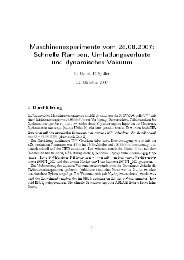
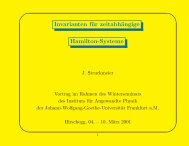
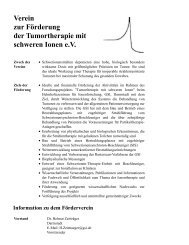
![GS I -P-]-17 - GSI Helmholtzzentrum für Schwerionenforschung](https://img.yumpu.com/20698964/1/184x260/gs-i-p-17-gsi-helmholtzzentrum-fur-schwerionenforschung.jpg?quality=85)

